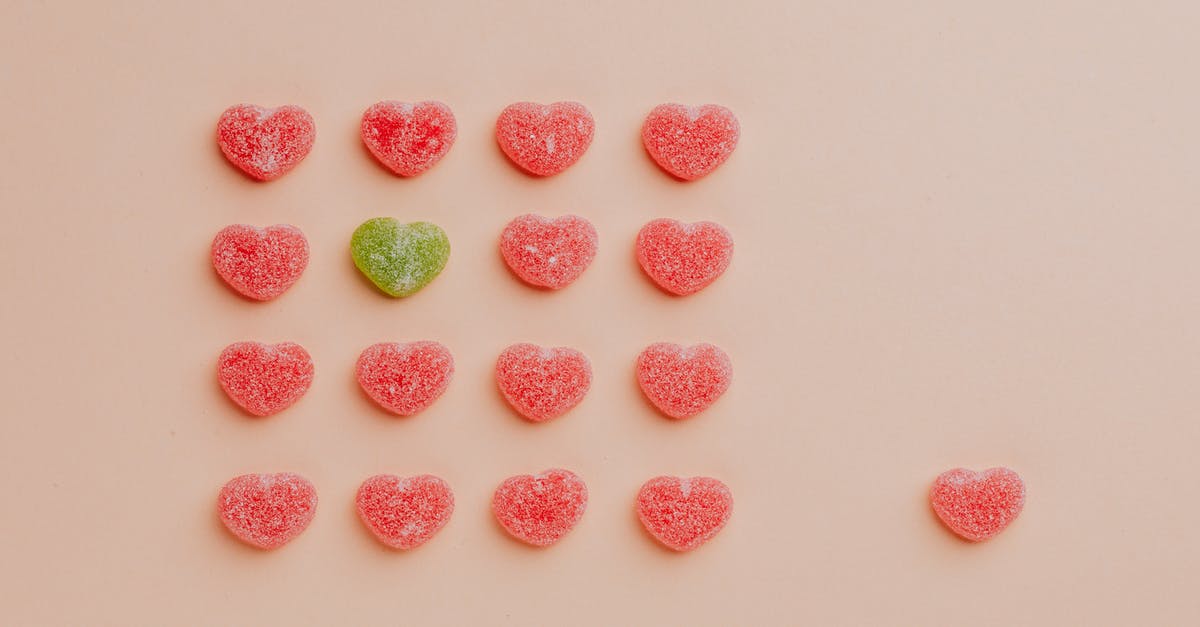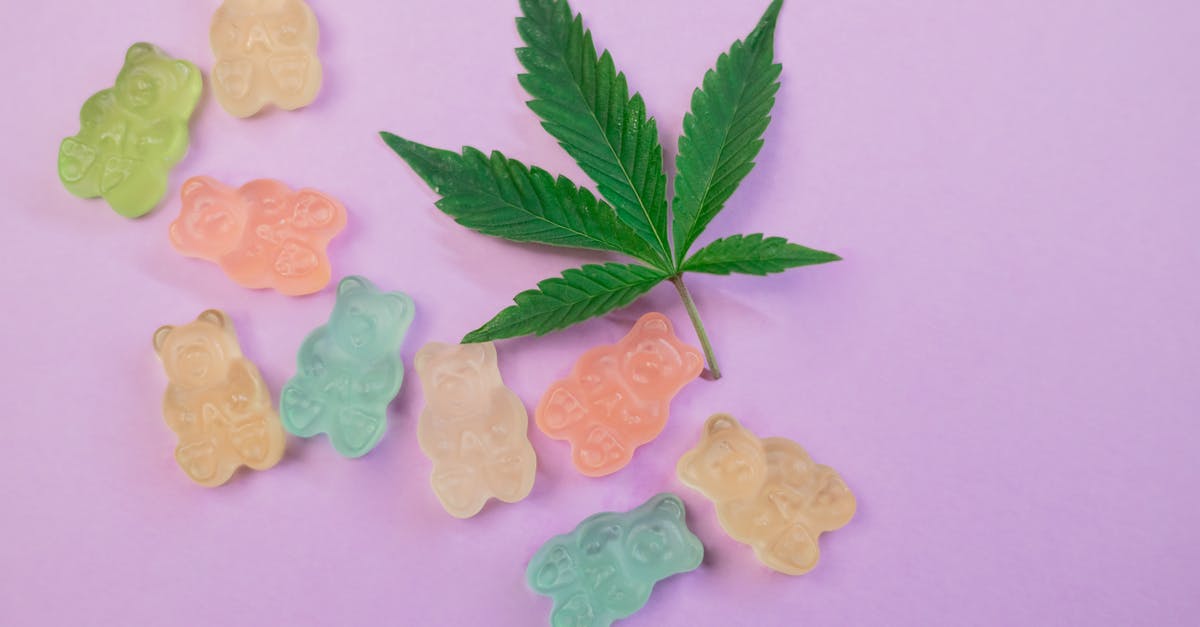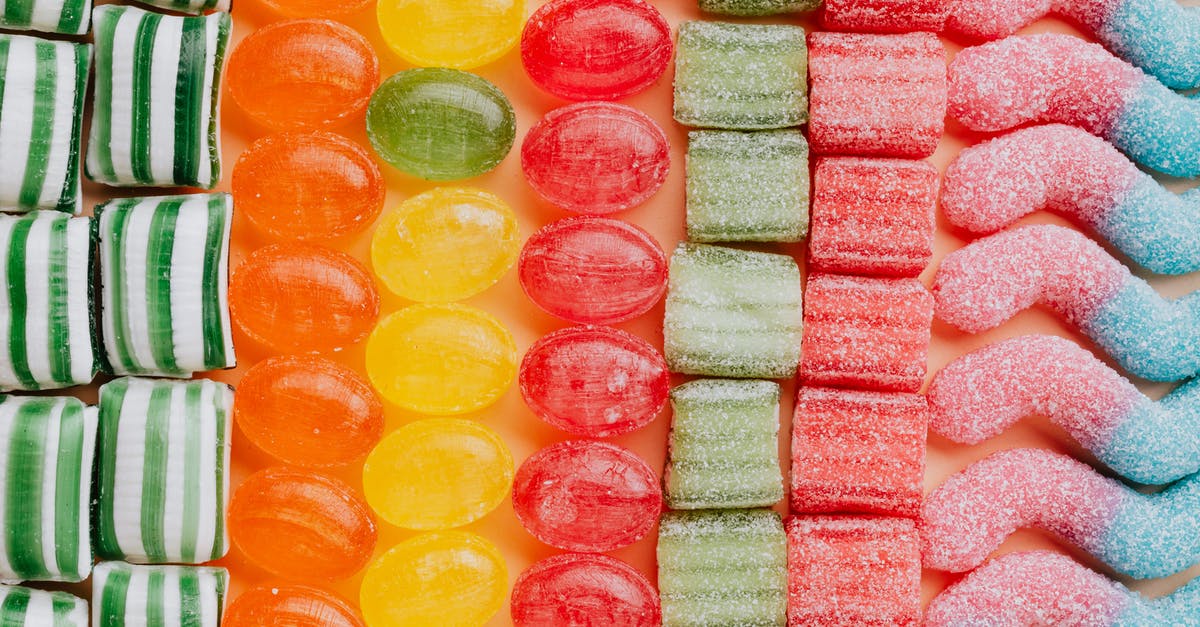Problem with gummy-bears being too much like jelly

I've been trying a simple recipe I found on the internet, which is a simple recipe consisting mostly of gelatin.
The problem is that the end result is basically just a fruit-flavoured jelly (Jell-O?), rather than the more chewy gummy-bears (Haribo) style of jelly confectionery.
Can anyone suggest what I need to do to make them less springy and more chewy. It's all difficult to articulate!
Here's what I used for the first test-batch:
- 12 tbsp sugar
- 12/3 cup fruit juice
- 8 tbsp Golden Syrup
8 tbsp gelatin
- soften the gelatin in 1/2 cup of cold water.
- place sugar, syrup and the juice in a pan and gently heat until sugar dissolves.
- Stir in the gelatin and stir until dissolved.
- Pour into moulds and wait until set.
Thanks
Best Answer
Be careful of substituting agar or any other "firm" gelling agent; you're likely to end up something closer to Turkish Delight and agar in particular has the property of syneresis (meaning that your gummy candies will dry up fast).
I can think of a few things that would alter the consistency of a gelatin candy/dessert:
First, it is very important to let the gelatin bloom. When it says to "soften" it in cold water, you need to let it sit there for a good 5 minutes or so until it has absorbed plenty of water and you can actually see a gel forming. Don't stir it at this point!
All gelatins are not created equal; you need to look at the bloom strength. I think the most common kind in supermarkets is Knox, which has a bloom strength of 225 and is usually what most gelatin recipes calls for. "Platinum" gelatin (normally sold in sheets) goes up to 260, "Gold" is generally around 200, "Silver" is 160, and "Bronze" can be as low as 125 - practically useless for this. If you managed to find powdered gelatin with a bloom strength of under 200, you would need to increase the quantity or else end up with jelly.
Although gelatin does not require particularly high temperatures to hydrate, you do need to heat the solution to at least 50° C before you set it. If you don't do this, it won't dissolve properly.
When using powdered gelatin, you're normally supposed to bloom and dissolve it in the same liquid. The recipe you have seems to call for chucking the bloomed gelatin directly into your syrup; this may be deliberate in order to produce some effect I'm not familiar with, but it sounds like an oversight to me. Instead I would heat the gelatin/water solution up to 50° C after blooming (as described above) and then add that to the syrup.
Finally, as Computerish says, make sure you're heating the syrup solution enough to get all the sugar dissolved, and you might even need to reduce it a little (let it simmer). The more you reduce it, the more viscous the syrup itself will become (at the extreme end turning into pure caramelized sugar, which is rock-hard). So if you're absolutely sure that you are using the gelatin correctly, this would be the next line to pursue. If the syrup is actually syrupy at room temperature then it should form great chewy gummies, but if it's watery then you're more likely to end up with Jell-O.
Pictures about "Problem with gummy-bears being too much like jelly"



Why are my homemade gummy bears so sticky?
The major bottleneck in pectin based gummy candy is to achieve a somewhat chewy texture as it is meant to be jelly-like. The tricks here are to maintain a precise pH of 3.5 during gel setting and not to heat up the pectin-sugar-water mixture beyond 220-240\xb0F, otherwise the candy may become sticky and caramelized.How do you make gummies less rubbery?
Conclusion: You need corn syrup or an invert sugar (even honey!) in gummies so that they stay soft and chewy. Pour all the dry ingredients in a bowl and mix them together. Then you can add the water and corn syrup.Why are my gummies mushy?
Forgetting to hydrate the gelatin. Because powdered gelatin is so fine, it may seem like it will dissolve in the warm liquid. Blooming, the other term often used for hydrating, ensures that the gelatin will dissolve completely in the warm base and also ensures a clear, even gel.Why are my edible gummies sticky?
Once you add enough oil to your candy it will not set properly \u2013 Oil does not want to combine with the hard, crystalline candy structure, a process referred to as \u201cemulsification\u201d. Without proper emulsification you'll get candy that's runny, tacky to the touch, or weeps liquid.More answers regarding problem with gummy-bears being too much like jelly
Answer 2
Heh... I used to work for a large commercial gummy-bear manufacturer, and can tell you that, when fresh, they were quite springy. A day in the drying room, followed by a couple months in the warehouse / on the shelf waiting to be sold, and they lose that springiness. Frankly, they all taste stale to me now. So yeah, try leaving them uncovered in the fridge for a few days & see if they're not more to your liking.
BTW: candies like these are almost always formed in molds pressed into food starch. This is primarily done to allow easy removal (just dump and shake), but I suspect also works to absorb excess moisture (I've since learned it also hastens cooling and setting of the outside of the candies, which also improves handling). And the ones we sold had a mineral-oil glaze that kept them from sticking to each other in the package - this also altered the taste / mouth-feel somewhat.
Answer 3
I have been struggling with this for a while now, and I have finally made a batch that is JUST like store bought! It is a little more complicated and will require you to heat the sugar to 240 F (soft-ball stage)
1st part
1 Cup Sugar
3 Tbsp Water
3/4 Cup Corn Syrup
2nd part
1/2 cup water
7 packets (46 grams) Gelatin (I used knox)
14 grams fruit pectin
3rd part
1 1/4 tsp Citric powder
2 tsp water
Flavor, Color
Mix 1st part in pot, begin heating this to 240 degrees Fahrenheit (soft-ball stage) while you prepare the 2nd part.
In another pot, prepare 2nd part.
Add the water, sprinkle gelatin over the top evenly and allow the gelatin to absorb the water.
After 5-10 minutes begin heating the pot with the gelatin, not exceeding 170 degrees Fahrenheit, stirring until the gelatin is all melted and the liquid is smooth. Slowly add fruit pectin to the gelatin mixture, stirring.
Once the sugar-syrup mix reaches 240 degrees, remove from heat and allow to cool down to about 212 degrees Fahrenheit.
Slowly pour the sugar-syrup over the gelatin-pectin, stirring to remove bubbles.
Add 3rd part, stirring until smooth. (do not wait too long to pour into molds!)
Let sit in refridgerator until they are as tough as you want, but mine were a great consistency in about an hour or so! Enjoy!
Answer 4
What has really worked for me is using 3/4 cup cold liquid (water, juice) slowly mix 6 or 7 packets of gelatin ( it doesn't really matter what type you use for this; into liquid do this in a sauce pan. This must be sprinkled in slowly while mixing the liquid. This will stem gelatin clumps and/ or bubbles. Let it sit for at least 10 min. It will be pretty clumpy and hard when you get back to it. Mix 1/3 Glucose ( not corn syrup or another variation, must be glucose) and 2/3 cup sugar. Depending on liquid used you may want to use. You may want less sugar if you use fruit juice. Once mixed turn on stove to low. Let the mixture melt slowly, mixing often, if you don't do this the mixture can burn. Once mixture is dissolved, take off heat. Mix in citric acid ( for taste). If you want all natural you may use a mixture of lemon juice and water for the liquid. This keeps the candy from tasting like straight up sugar. Mix in candy flavoring, not extract ( extracts have water in them this will affect the texture) lor-Ann or Wilton make great candy flavored. Pour into silicone molds. Put in freezer for an hour. Then you will have gummy candy. They can be stored in the fridge or in a cool dark place in a container. The more gelatin you use, the more rubbery the candy will be. It won't be exactly like store bought gummies, for the reasons above. Freshness contributes to a huge part of that. Depending on how much you would like to spend, gelatin can come in different blooming strengths. That can also help w/ the chewy issue. Gelatin sheets have a higher blooming strength. However, they cost more. I use good old gelatin you get at the store. Amazon has been really great for finding candy making ingredients. Also it's good to research the science behind it. It will help you to be able to experiment w/ different geling agents. One geling agent I don't recommend is agar agar it makes gummies gritty and has an aftertaste. Below is the link for detailed descriptions of what different geling agents can do a bit of confectionery geekry.
https://www.chefsteps.com/activities/confectionery-geekery
Hope this helps :).
Answer 5
I've been working on this problem over the last few months. I have recently tried adding cornflour to the mixture, so I would mix up a heaped teaspoon in a small amount of lemon juice until there were no lumps, and stir that into my still hot syrup/flavour/gelatin mix. This has given them much more of a chewy texture once dried out for a week or so. This was reverse engineered from some sweets I bought.
I spent some time getting the soft-ball sugar syrup right, and even when it was soft balled, once the chewies were out of the freezer, they were still springy like Jell-O (like @Shog9 said) and required drying for a week. I have dried them in a mixture of flour and icing sugar; however it should be possible to oven dry such mixtures at low temperatures.
UPDATE:
Don't put them in the freezer. This hugely extends the drying time. Let them dry on a top shelf or somewhere, probably for a week or two. This seems to give the required texture.
Answer 6
Changing the gelling agent could help as justkt suggested. I suspect, however, that your problem is the temperature of the sugar. The recipe I have (from Chocolate and Confections, but I haven't actually tried this recipe) suggests heating the sugars to 275 F and then cooling to 242 F before adding the gelatin.
Since you are using juice and not a pre-made flavoring (+1 for that by the way), you might want to reduce the juice by about 50% in advance (cook it until it is half of its original weight and then let it cool again) and add it after the sugar has been cooked.
Answer 7
You must dehydrate them, as the professionals do in the drying room. I have a dehydrator and it works PERFECTLY to give them the firmness you are seeking.
I use a simple recipe as I like splenda/sugarfree gummies. Ingredients: ½ cup water ¼ cup Crystal Light Powdered drink mix with Splenda ¼ cup gelatin (that’s equivalent to 4 packets of Knox)
1.Mix the powders together and add water. 2.Stir quickly into gelatin till it’s completely saturated 3.Microwave for about 1:15 min (micro times vary, you want to melt the gelatine without boiling, so keep an eye on it till you have yours figured out, it’ll foam a bit – that’s normal) 4.Remove from microwave and stir 5.Freeze until gelled (10-20 minutes, Knox seems to set quicker) 6.Cut it into squares and voila…yummy gummies!
For firmer gummies, dehydrate on low until they are as firm as you want. They can get very hard if you dry them too long.
Makes approx 5.2 oz of gummy candy, 100 calories total
These are great to snack on at work sitting at a computer!
Answer 8
I guess that you could add more flavored gelatin, but if you are worried about having a salty flavor( because you will if you use too many packs of unflavored gelatin and the gummies do not have enough flavor) then you could substitute the water or whatever liquid your using for fruit juice.
Sources: Stack Exchange - This article follows the attribution requirements of Stack Exchange and is licensed under CC BY-SA 3.0.
Images: Karolina Grabowska, Kindel Media, Karolina Grabowska, Kindel Media
